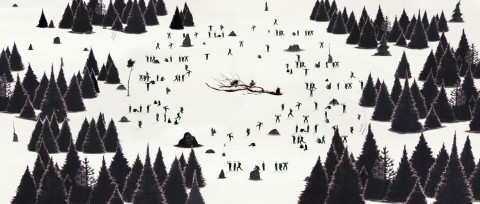Robyn O’Neil is devoted to drawing. Influenced by Bosch and Bruegel, she creates intricately detailed, large-scale drawings that reflect the harshness of the natural world and the foibles of humanity, using only a .5 mm mechanical pencil. Both serious and absurd, O’Neil’s imagery since 2000 has evoked the precarity as well as the beauty of the earth and its creatures in expansive landscapes populated by middle-aged white men clad in black tracksuits and white sneakers. Their uniforms recall suburban lifestyles and the Heaven’s Gate cult, whose members committed mass suicide in 1997, and they engage in bizarre behaviors, sometimes harming and sometimes helping one another.
In vast barren wildernesses, they play sports and aimlessly wander, but also hit and embrace each other and torment animals. An exploration of the impact and consequences of human behavior on the environment, this series of drawings later would depict the men amid dead trees, surging oceans, and other extreme conditions, foretelling the catastrophes of climate change that are all too frequent today. O’Neil explains, “I wanted this to be a tale about how, if they treat themselves, animals, and the land horribly, then our world is going to crumble.” She began to kill off the men around 2007, stranding and drowning them in a tsunami in the 7 x 13-foot drawing Masses and masses rove a darkened pool; never is there laughter on this ship of fools (2007) and finally suspending the last man on earth in the sky. The tiny figure hangs precariously from a slack rope soon to meet his fate with the monumental roiling ocean waves below him in These final hours embrace at last; this is our ending, this is our past (2007).
More recently, O’Neil has introduced colored pencils and pastels into her work, focusing on sweeping, layered imagery of animals that remains no less psychologically and visually charged. This new direction exemplifies the artist’s contention that “[humans] are not the center of our world.” Rather than being victims of O’Neil’s little men, her birds and bison animate and even overwhelm the compositions. Nonetheless, the men reappear in Hell (2011), a three-panel collaged drawing, in which they suffer in the titular location, and in the video WE, THE MASSES (2011).
In 2010, O’Neil enrolled in director Werner Herzog’s Rogue Film School in Los Angeles, an experience that led her to bring her figures to life in collaboration with Irish animator Eoghan Kidney. In WE, THE MASSES, a man drops from the sky and jumps off a cliff, as we follow him to an all-male community in a frozen tundra-like environment. The group engages in odd activities—holding awkward poses, playing with sticks, ice-skating, and jumping up and falling prostrate on the ground. The earth then cracks open to reveal a celestial orb, of which our protagonist takes possession, and waters engulf the landscape. Yet, next we find the men floating on wooden rafts. Eventually one of the men threatens the central character, who falls into the ocean, along with the orb, but both reappear in the final scene.
The orb hovers in the sky before crumbling into the ocean, and a rope miraculously appears to lift our hero triumphantly above the water. However, he lets go seconds later and plummets back into the dark abyss. As the video ends, one wonders if this is the actual ending. Could this fall function like those that introduced the man to us, that led to his wondrous journey of recurring endings and reappearances? Perhaps he descends to illustrate what O’Neil has asserted, “Endings can be inconclusive, but yet are still called ‘endings.’ They are also starting points; things must end so that something else will happen.” –Kanitra Fletcher

